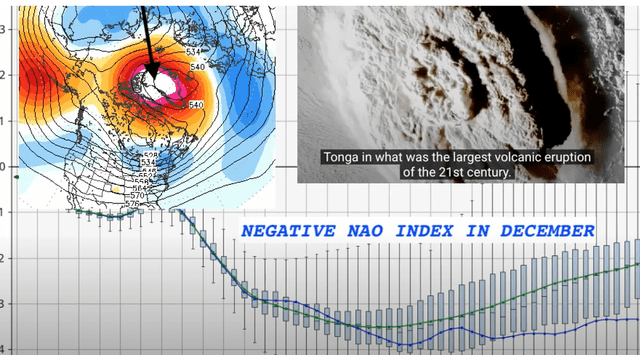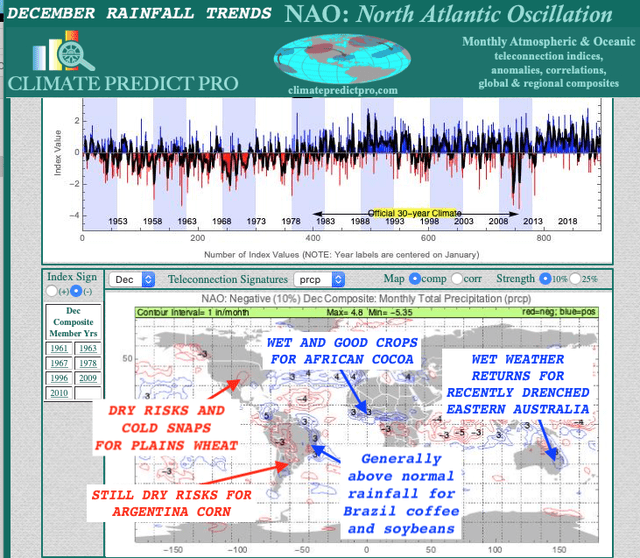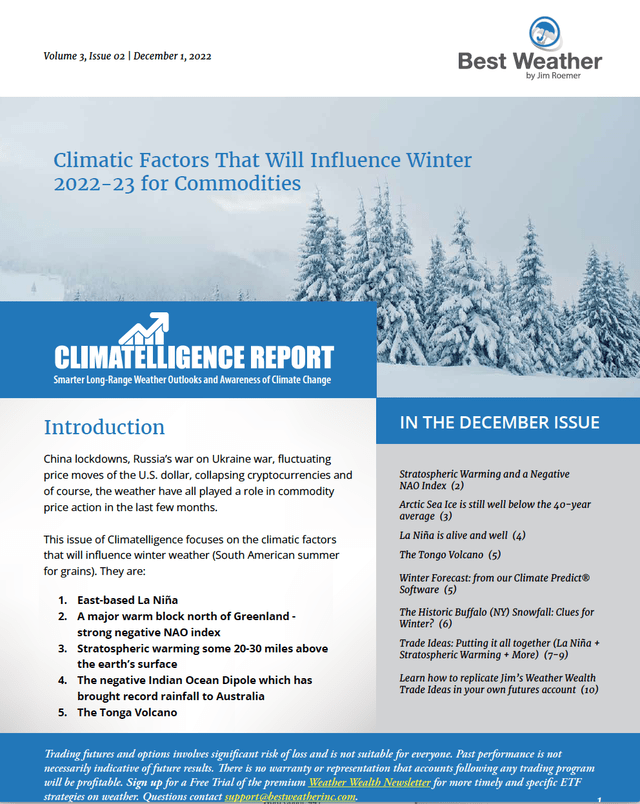SrdjanPav/E+ via Getty Images
This video discusses the many factors that will be causing the atmosphere to switch to a very powerful negative NAO index in December. The result should be a cold potentially snowy early winter for parts of the eastern half of the United States, plus parts of Western Europe, after December 13th.
So far, the natural gas (UNG) market has resumed its downtrend because U.S. supplies are ample and a warm fall has helped create historic market volatility.
Strong negative NAO index (Weather Wealth newsletter)
While some meteorologists and other scientists believe that a huge volcano like Tonga could cause longer-term cooling effects on the climate, I disagree. This historic underwater volcano that erupted last January actually warmed, not cooled, the atmosphere. Nevertheless, the continuation of stratospheric ask can have an effect in causing warming aloft and hence a negative NAO index, as you see above.
According to a team of New Zealand scientists, the January 15th eruption in the Tongan archipelago in the South Pacific Ocean was the “largest ever recorded” with modern equipment. The eruption reached record heights, being the first we’ve ever seen to break through into the mesosphere.
The last time we had close to a similar eruption was at Mt. Pinutuba in 1991. This helped spawn the three-year El Nino event from 1992-1994. This could happen again by next summer or fall and would mean longer-term bearish grain prices next year.
While this eruption was large, one of the biggest since Krakatoa in 1883, there have been others of similar magnitude since then that didn’t behave in the same way. The difference here is that it is an underwater volcano and it’s also part of the reason it generated such large tsunami waves.
Most recently, the eruption of the Hawaiian Manu Loa volcano for the first time in 40 years should have little impact on the climate. The volcanic aerosols have not reached the stratosphere.
Other than La Niña, my in-house weather program shows the potential December rainfall trends based on a negative NAO index. Notice the continuation of crop issues for Plains wheat, good weather for west African cocoa, more wet weather for Australia, generally good crop weather for Brazil coffee and soybeans, but problems for the Argentina corn crop.
A La Niña event, combined with a December negative NAO index, only happens once every 7-10 years. The result is “usually” a cold early winter for both the eastern half of the U.S. and Western Europe. However, due to the warming Arctic and, actually, a warming (not cooling) climate inspired in part by the January 2022 Tonga volcano, and climate change, the historic severe winters of the 1970s and early 1980s are likely something that will not be repeated.
December impacts of a negative NAO (climatepredict.com)
Conclusion:
Drought risks remain for Argentina corn (CORN), a potential cold December for Europe and the eastern U.S. with lots of snow. The Brazil soybean (SOYB) and coffee crops (JO) will continue to benefit from South American weather
The extent of the worst of the cold due to a -NAO may be over Asia. Nevertheless, the weather will become a major factor in commodity trading in the next few months, as markets switch from demand worries to more weather plays.
The headlines of my newsletter this month are shown below. Feel free to learn how to use weather to trade commodities
CLIMATELLIGENCE–JIM ROEMER’S MONTHLY NEWSLETTER (bestweatherinc.com)


Be the first to comment